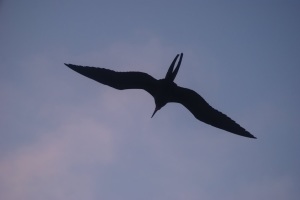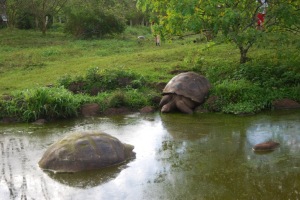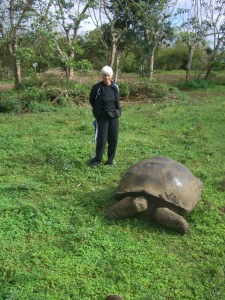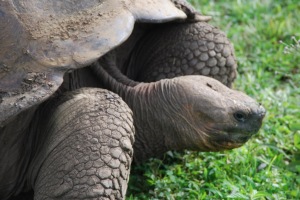
These isles have not lost a drop of enchantment – at least where the animals are concerned. They don’t seem to fear humans, normally the number one predator of every specie and place. Where else can one skip across prehistoric marine iguanas, hop out of the way of engaging sea lions and fur seals, stand an arms length away from birds mating and nesting on the future generation, where else do non-bird-watchers become avid proponents of bird songs, become well-acquainted with fifteen types of Darwin’s finches (look at their beaks) and the funky blue-footed boobies chorus girl kick mating dance, or become able to identify red throated male frigates from the white chested female as they soar over the ship’s decks?
Isn’t it odd that here and in Antarctica frigates are the most visible of seabirds (they are called man of war birds because they aren’t too friendly with other sea birds) but frigate legends are part of the foundation of Easter Island – remember the birdman competition? The frigate was the model for most of the petroglyphs recording that tradition. Yet I saw not one frigate there. Here in Galapagos, the mating season is the game, so male frigates put on a grand show – claiming a piece on some sort of vegetation, inflating their red gular pouch like a balloon until a female, flying overhead and making a “mooing” sound, can no longer resist. Se la vie.
 The finale on Galapagos was meeting with unbelievable giant tortoises on Santa Cruz Island, which in itself has oddball climate. We docked in our Zodiacs where a bus drove us on a paved road flat as a knife straight through to Los Gemelos, two huge twin sink holes – one on each side of the road. Did comets fall there to create such canyons?
The finale on Galapagos was meeting with unbelievable giant tortoises on Santa Cruz Island, which in itself has oddball climate. We docked in our Zodiacs where a bus drove us on a paved road flat as a knife straight through to Los Gemelos, two huge twin sink holes – one on each side of the road. Did comets fall there to create such canyons?
But oddest was after three miles in dry, starving landscape, as we rose to a higher elevation (a 40 minute bus ride)and temperatures dropped about 20 degrees (we had to close the bus windows) until we were smack in shades of green – the native scalesia forest covered in green moss, but also man-planted papaya, banana, mango trees, and hibiscus and bouganvilla. On the far side of Santa Rosa pueblo, is the Giant Tortoise Reserve, where these giant remnants of prehistoric days are watched, protected and studied by naturalists. We didn’t have to wait long to spot a tortoise: one of these giant slow moving boulders was stopped in the middle of the road blocking bus movement. Anxious to keep on our schedule, (it was late in the afternoon) a group of men exited the bus to encourage the poor tortoise to move on off, and ended up having to lift it up and plant it on the side of the road, none the worse for wear. The giant tortoises have the r ight of way and look like invasive rocks in local farmers fields.
ight of way and look like invasive rocks in local farmers fields.
At the reserve, I had the chance to look face to face at many tortoises, their mouths dripping with fresh green grass, their life one of moving about two miles a day in circles and feeding. Man – hungry for meat and shell – practically wiped out these enormous pre-historic place. Although there is some rain specifically in Santa Rosa, mostly Galapagos is dry. There is no fresh water, and that has to be imported or caught in water towers during the rainy season. The giant tortoise , weighing about 700 pounds, has adapted to dry conditions although in this reserve there were mini-ponds filled with algae in a cooler climate. Just here, mind you. Other tortoises said to be much larger (these were large enough) survive in a small area on Isabela Island.

We were told not to stand or pass in front of the turtles, that frightened them. Of course most tourists did anyway taking ridiculous photographs to make themselves look as if they were touching or riding the tortoises. Once that was allowed, according to seductive tourist propaganda showing children riding the tortise or kissing him, but now no longer. If the tortoise began hissing, that meant he or she was frightened and the head, at one point reaching for fresh green grass, jerks back in under the shell. In a private field turned over to tortoises, there must have been dozens scattered and grazing, and appearing a bit disturbed by the bus loads of tourists. We moved through quickly and at the end of the short stroll in tortise fields, was a small souvenir stall and tea area where I had the best cheese empanada of the trip. (Cheese in pastry and fried to a huge puff, in this case.) 
Just to not confuse you’all, these land tortoise walks on elephant size feet with huge toenails. Their movement is only on land, they would sink to the bottom of the sea. The feet of the green sea turtles with shells about the size of a giant pizza pan (with whom I swam) have evolved out of necessity into flippers or paddles because their entire life is in the sea. Annually, the female goes ashore (and it takes a long time to move a few feet) to lay her eggs in the sand. She actually has to dig the bed with her flippers, a long, tedious process which only the females engage in. Since she cannot survive on land, she stays three or four days on the nest, then returns to the more friendly environment of the sea. The eggs hatched on their own. Some survive. Some are eaten by predators.
Such observations sparked Charles Darwin’s naturalistic mind when he stopped on the Galapagos Islands in 1835 during a round the world excursion on the Beagle ship. I’m reading his journal of that trip that brought him to Galapagos and Easter Island, “The Voyage of the Beagle,” recording his virgin observations on those travels all over South America that led to his writing “Origins of the Species.” It’s amazing how everything fits, adapts, survives in partnership, and changes according to need. A guide humored me when I asked what was the white and yellow scruffy debris floating on top of the sea. He explained it was excrement from the penguins, seals, fur lions, whales and birds that becomes the main meal of fish and marine life. Fishermen catch the fish, ship it to market, we buy fish raw, eat it and the circles goes on. So, to make a point, when we eat fish, we eat the sea animals poop. Oh well. I guess it works.
